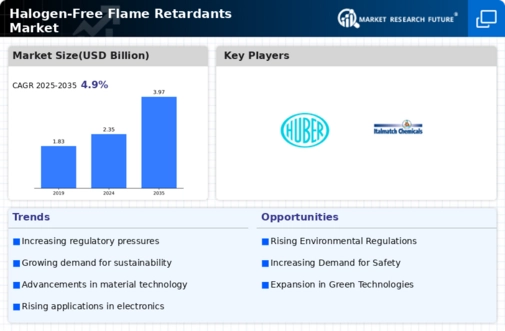Market Share
Halogen-Free Flame Retardant Market Share Analysis
This report delves into the global halogen-free flame retardants market, employing segmentation based on type, resin type, end-use industry, and region for a comprehensive analysis. The market types include aluminum trihydrate, phosphorous-based, magnesium hydroxide, and others. Among these, the aluminum trihydrate segment claimed the largest market share, amounting to 45.34% in 2017 and a market value of USD 993.83 million. In terms of volume, this segment measured 984.69 thousand tons in 2017, projecting growth to 1339.02 thousand tons by the close of 2023. The dominance of the aluminum trihydrate segment is expected to persist throughout the forecast period, primarily due to its cost-effectiveness compared to other halogen-free flame retardants.
Considering resin types, the polyethylene segment emerged as the leading contributor, valued at USD 533.99 million in 2017, and is poised to reach USD 775.98 million by the conclusion of 2023. Following closely is the polypropylene segment, which accounted for 20.16% of the total market in 2017, with a value of USD 441.94 million, projected to ascend to USD 629.86 million by the end of 2023.
Geographically, Asia-Pacific is anticipated to lead as both the largest and fastest-growing market, comprising 47.11% of the overall market share in 2017. This regional dominance can be attributed to the robust growth of end-use industries like building and construction, electrical and electronics, transportation, and consumer goods. The market in Asia-Pacific is forecasted to reach USD 1,465.06 million by the culmination of 2023.
Examining the market by type reveals a competitive landscape with diverse options such as aluminum trihydrate, phosphorous-based, magnesium hydroxide, and others. The aluminum trihydrate segment, securing the largest market share in 2017, is characterized by a market value of USD 993.83 million. Its dominance is further emphasized by the substantial volume, reaching 984.69 thousand tons in 2017 and projected growth to 1339.02 thousand tons by the close of 2023. This particular segment's ascendancy is attributed to its cost-effectiveness compared to alternative halogen-free flame retardants. As industries increasingly seek economical solutions without compromising on fire safety standards, the aluminum trihydrate segment is expected to maintain its prominence in the market.
Considering resin types, the polyethylene segment commands a leading position, valued at USD 533.99 million in 2017, and is predicted to reach USD 775.98 million by the end of 2023. Following closely is the polypropylene segment, representing 20.16% of the total market in 2017, with a value of USD 441.94 million and an expected growth to USD 629.86 million by the conclusion of 2023. The significance of these resin types lies in their widespread use across various industries, especially in applications such as plastics, composites, foams, textiles, paints, and coatings. As these materials continue to be pivotal in sectors like building and construction, electrical and electronics, and consumer goods, the demand for halogen-free flame retardants in polyethylene and polypropylene is projected to remain substantial.
In terms of geographical distribution, Asia-Pacific emerges as a key player, both in terms of current market dominance and future growth. Accounting for 47.11% of the overall market share in 2017, the region is characterized by aggressive growth in crucial end-use industries such as building and construction, electrical and electronics, transportation, and consumer goods. The market in Asia-Pacific is on track to reach USD 1,465.06 million by the end of 2023, underscoring its pivotal role in the global halogen-free flame retardants market.






Leave a Comment